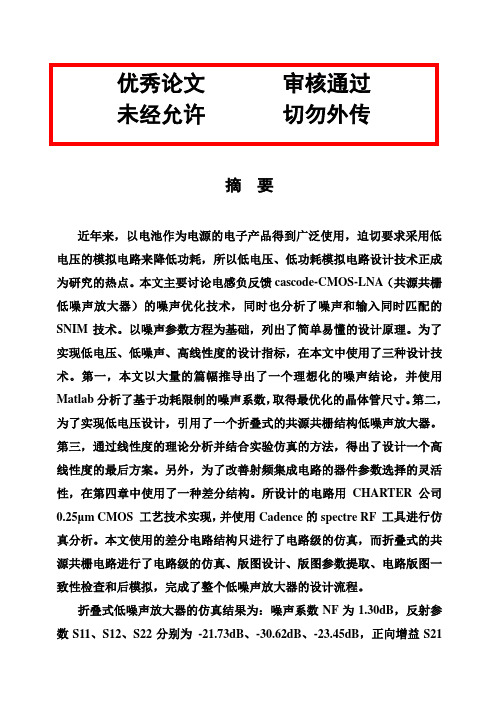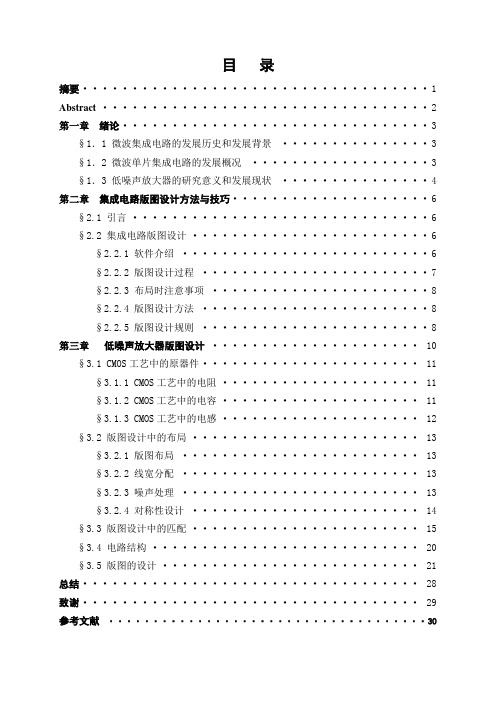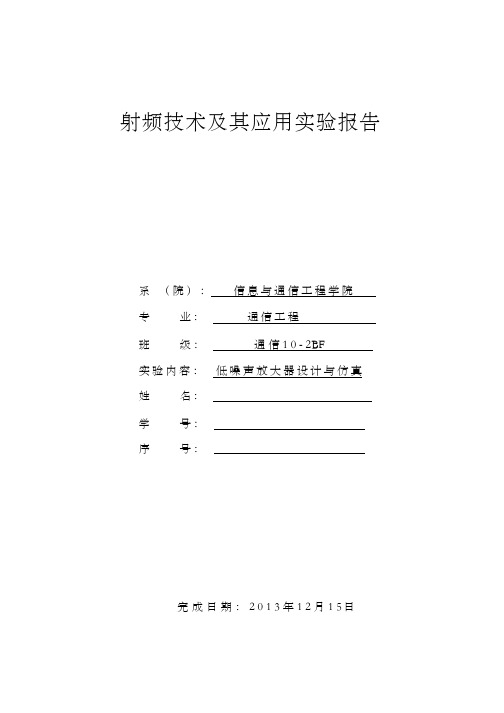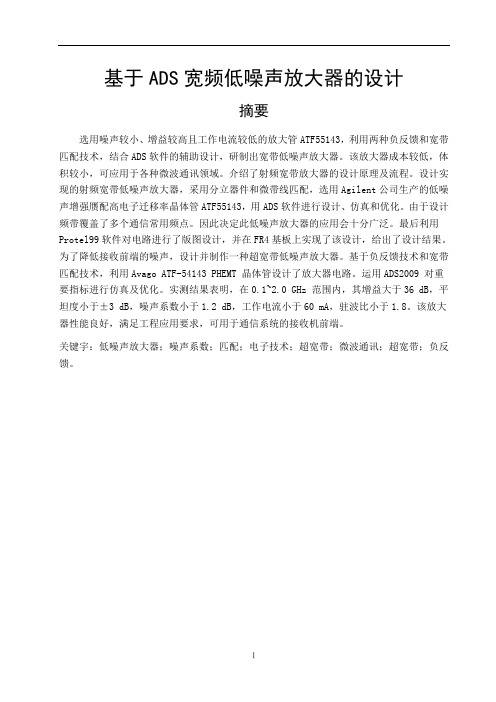(完整版)低噪声放大器设计仿真及优化毕业设计
低噪声放大器(LNA)仿真与设计ADS

导体中的噪声功率表示为: Pn kT f kTB
1 Gmax
(1)
其中K为波尔兹曼常数,T是绝对温度用K表示,
而 f B 是测量系统的噪声带宽 B
RS
+
0
G ( f )df
匹配条件下:
RL RS
Vn RMS
) - )
Vn2RMS Pn kTB 4RS
根据分析,为获得最小的FET本征噪声,从FET输入口P1面向信源方向 视入的反射系数有一个最佳值,用out表示。当改变输入匹配电路使呈现
2019/1/9
三、低噪声放大器基础知识
1.3 放大器常用元器件
2.三端的晶体管器件
双极晶体管(BJT)
金属半导体场效应管 (MESFET) 拟晶态高电子迁移率晶体管(PHEMT) 异质结晶体管(HBT)
2019/1/9
三、低噪声放大器基础知识
1.4 放大器的技术参数
(1)频率范围: 放大器的工作频率范围是选择器件和电路拓扑设计的 前提。 (2)增益: 它是放大器的基本指标。按照增益可确定放大器的级 数和器件类型。 实际功率增益:负载吸收功率与二端口网络输入端吸收功率之比,
实际增益测量时,常用插入法,即用功率计先测信号
源能给出的功率P1;再把放大器接到信源上,用同一功率 计测放大器输出功率P2,功率增益就是
P2 G P1
低噪声放大器都是按照噪声最佳匹配进行设计的。噪
声最佳匹配点并非最大增益点,因此增益G要下降。噪声 最佳匹配情况下的增益称为相关增益。通常,相关增益比 最大增益大概低2-4dB。
由(1)和(2)
(2)
电路的噪声电压
Vn RMS 4kTBRS
低噪声放大器设计-线性仿真

L=2.18 nH
PORT P=2
Z=50 Ohm
最终结果
❖ 将频率再设回最初的宽频带: 0.1~20GHz ❖ 增益,匹配,噪声结果:
20 10
0 -10 -20 -30 -40
0
Gain And Match
DB(|S[2,1]|) Amplifier
DB(|S[1,1]|) Amplifier
1
3
RES ID=R2 R=300 Ohm
TLIN ID=TL1 Z0=75.4 Ohm EL=90 Deg F0=5 GHz
PORT P=1
Z=50 Ohm
RES ID=R3 R=20 Ohm
RES ID=R1 R=450 Ohm
PORT P=2 Z=50 Ohm
CAP ID=C1
C=100 pF
-0.2 -0.4
-0.6 -0.8 -1.0
-2.0
Swp Min 0.1GHz
测量增益参数
❖ 创建图表:Two Port Gain,测S21.MSG ❖ 重设频率坐标:取消Auto,设起始值为0
40 30 20 10
0 0
Two Port Gain
DB(|S[2,1]|) Device
DB(MSG) Device
PORT P=1 Z=50 Ohm
CAP ID=C1 C=100 pF
IND ID=L1 L=2.5 nH
PORT P=2 Z=50 Ohm
IND ID=L2 L=4.37 nH
❖ L1. L2 为可调受限变量,设置如下:
说明: 元件属性设置与变量 调节器是相互对应的。
❖ 调节L1.L2 ,在噪声、增益、匹配之间找 个平衡点
基于ads仿真的低噪声放大器设计论文

基于ads仿真的低噪声放大器设计论文论文题目:基于ADS仿真的低噪声放大器设计摘要:低噪声放大器在无线通信系统中具有至关重要的作用,能够提高信号传输的质量和可靠性。
本论文基于ADS仿真平台对低噪声放大器的设计进行研究和优化,采用一种新颖的设计方法,以降低放大器的噪声系数,提高系统的性能。
首先,通过对低噪声放大器的原理和特性进行深入分析,确定了设计的目标和要求。
然后,利用ADS仿真工具进行电路设计和参数优化,并进行了相应的性能评估。
最后,通过实验验证了设计的有效性和可行性。
关键词:低噪声放大器、ADS仿真、噪声系数、性能评估、实验验证1.引言低噪声放大器在无线通信系统中起着关键作用,能够提高信号传输的质量和可靠性。
在设计低噪声放大器时,关注的主要指标是放大器的噪声系数。
低噪声放大器的设计需要考虑到多种因素,包括频率响应、幅度稳定性、增益平坦度等。
本论文旨在通过ADS仿真工具来实现低噪声放大器的设计和评估,优化其性能。
2.低噪声放大器设计原理3.ADS仿真工具的应用ADS是Agilent技术公司开发的一种射频和微波电路设计与仿真软件,具有强大的仿真和优化功能。
在本论文中,将使用ADS仿真工具来实现低噪声放大器的设计和优化。
通过合理选择元器件和调整电路参数,我们可以得到一个满足设计要求的低噪声放大器。
4.低噪声放大器设计和优化首先,在ADS中建立低噪声放大器的电路模型,包括源极、基极和负载等部分。
然后,通过电路参数的优化,使得在给定的频带内,低噪声放大器的噪声系数降至最低,并达到最佳的增益。
5.性能评估通过仿真数据对设计的低噪声放大器进行性能评估。
主要评估指标包括增益、噪声系数、频率响应以及其他性能参数。
比较设计方案的优缺点,选择和调整最佳的方案。
6.结果分析与讨论对仿真结果进行分析和讨论,评估设计的低噪声放大器方案的可行性和有效性。
对于不符合要求的设计方案,可以对电路参数进行进一步优化,以获得更好的性能。
毕业设计(论文)-基于ads的微波低噪声放大器的仿真设计[管理资料]
![毕业设计(论文)-基于ads的微波低噪声放大器的仿真设计[管理资料]](https://img.taocdn.com/s3/m/4a3b8925b9f3f90f77c61b2e.png)
毕业设计(论文)题目基于ADS的微波低噪声放大器的仿真设计所属院(系) 物电学院专业班级电子1201姓名学号:指导老师完成地点物电学院实验室2016年6月5日毕业论文﹙设计﹚任务书院(系) 物电学院专业班级电子信息工程学生姓名一、毕业论文﹙设计﹚题目基于ADS的微波低噪声放大器的仿真设计二、毕业论文﹙设计﹚工作自 2016 年 2 月 20 日起至 2016 年 6 月 20 日止三、毕业论文﹙设计﹚进行地点: 物电学院实验室四、毕业论文﹙设计﹚的内容要求:(LNA)广泛应用于微波接收系统中,是重要器件之一,主要用来放大低电平信号,由于是自天线下来第一个进行信号处理的器件,LNA决定了整个系统的噪声性能和电压驻波比VSWR,,往往需要对驻波比和噪声性能参数指标进行处理。
那么如何对这两个性能参数进行处理就成为低噪声放大器设计中的一个难点。
这个难点的最好解决方法就是放在放大器输入输出匹配网络的设计中来解决。
本设计是利用微波射频仿真软件ADS对微波低噪声放大器进行仿真设计,掌握微波射频电路的工程设计理论和设计方法,提高专业素质和工程实践能力。
其具体要求如下:1、分析微波低噪声放大器的各项参数;2、查找相关资料并翻译相关的英文资料;3、设计一微波低噪声放大器,根据所选器件,设计相应偏置电路;4、设计输入输出匹配电路,并利用仿真软件ADS对设计进行仿真验证。
进度安排:2月20日─3月1日:查阅资料、完成英文资料翻译并准备开题报告3月2日─4月1日:熟悉软件的使用并提交开题报告4月2日─5月1日:完善开题报告、研究微波低噪声放大器的理论设计方法、并建立偏置电路和匹配电路,进行期中检查。
5月2日─5月30日:利用软件建立微波低噪声放大器模型并进行仿真验证,准备验收。
6月1日─6月10日:撰写毕业设计论文并提交论文6月11日─6月15日:毕业设计答辩。
毕业设计应收集资料及参考文献:[1]低噪声放大器(LNA)[J].通信技术,2016(01)[2][D]电子科技大学,2009.[3][D]广东工业大学,2013.[4]. 2006.[5].[6] 射频功率放大器的研制[D].指导教师系 (教研室)系(教研室)主任签名批准日期接受论文 (设计)任务开始执行日期学生签名基于ADS的微波低噪声放大器的仿真设计学生:(陕西理工学院物理与电信工程学院电子信息工程专业电子1201班级,陕西汉中 723000)指导老师:[摘要]低噪声放大器用作各类无线电接收机的高频或中频前置放大器,以及高灵敏度电子探测设备的放大电路,低噪声放大器也主要面向移动通信基础设施基站应用。
低噪声放大器设计与优化

效率优化技术
功耗优化
根据低噪声放大器的性能需求,合理选择工作电 压和工作电流,降低功耗,提高能源利用效率。
偏置电路优化
设计高效稳定的偏置电路,为低噪声放大器提供 稳定的静态工作点,减小失真和功耗。
拓扑结构优化
采用合适的电路拓扑结构,如共栅、共源等结构 ,提高低噪声放大器的效率。
可靠性优化技术
元器件筛选与降额设计
噪声抑制的需求
在复杂电磁环境中,低噪声放大器的 性能直接关系到接收信号的质量,因 此对低噪声放大器的设计和优化具有 重要意义。
研究目的和意义
提高接收灵敏度
促进技术创新
通过对低噪声放大器的优化设计,可 以显著提高接收机的灵敏度,从而扩 大通信系统的覆盖范围和传输速率。
对低噪声放大器的研究有助于推动相 关领域的技术创新和进步,促进无线 通信技术的持续发展。
低噪声放大器设计与优 化
作者:XXX
20XX-XX-XX
CONTENTS 目录
• 引言 • 低噪声放大器的基本原理 • 低噪声放大器的设计方法 • 低噪声放大器的优化技术 • 实验与测试 • 结论与展望
CHAPTER 01
引言
背景介绍
无线通信系统的发展
随着无线通信技术的快速发展,低噪 声放大器在接收机前端扮演着至关重 要的作用,对整个通信系统的性能产 生重要影响。
放大器的性能指标包括增益、 带宽、噪声系数、线性范围等 。
低噪声放大器的特性
低噪声放大器是一种特殊的放大器,其噪声系数较低,能够提供更好的信号质量。
低噪声放大器通常用于接收机前端,以减小接收信号中的噪声干扰,提高信号的信 噪比。
低噪声放大器的增益较高,能够提供足够的信号幅度,同时保持较低的噪声系数。
宽带低噪声放大器ADS仿真与设计

宽带低噪声放大器ADS仿真与设计[导读]介绍一种X波段宽带低噪声放大器(LNA)的设计。
该放大器选用NEC公司的低噪声放大管NE3210S01(HJFET),采用微带阻抗变换型匹配结构和两级级联的方式,利用ADS软件进行设计、优化和仿真。
最后设计的放大器在10~13 GHz范围内增益为25.4 dB+0.3 dB,噪声系数小于1.8 dB,输入驻波比小于2,输出驻波比小于1.6。
该放大器达到了预定的技术指标,性能良好。
O 引言低噪声放大器(low noise amplifier,LNA)是射频接收机前端的重要组成部分。
它的主要作用是放大接收到的微弱信号,足够高的增益克服后续各级(如混频器)的噪声,并尽可能少地降低附加噪声的干扰。
LNA一般通过传输线直接和天线或天线滤波器相连,由于处于接收机的最前端,其抑制噪声的能力直接关系到整个接收系统的性能。
因此LNA的指标越来越严格,不仅要求有足够小的低噪声系数,还要求足够高的功率增益,较宽的带宽,在接收带宽内功率增益平坦度好。
该设计利用微波设计领域的ADS软件,结合低噪声放大器设计理论,利用S参数设计出结构简单紧凑,性能指标好的低噪声放大器。
1 设计指标下面提出所设计的宽带低噪声放大器需要考虑的指标:(1)工作频带:10~13 GHz。
工作频带仅是指功率增益满足平坦度要求的频带范围,而且还要在全频带内使噪声系数满足要求。
(2)噪声系数:FN<1.8 dB。
FN表示输入信噪比与输出信噪比的比值,在理想情况下放大器不引入噪声,输入/输出信噪比相等,FN=O dB。
较低的FN可以通过输入匹配到最佳噪声匹配点和调整晶体管的静态工作点获得。
由于是宽带放大器,难以获得较低的噪声系数,这就决定了系统的噪声系数会比较高。
(3)增益为25.4 dB。
LNA应该有足够高的增益,这样可以抑制后面各级对系统噪声系数的影响,但其增益不宜太大;避免后面的混频器产生非线性失真。
(4)增益平坦度为O.3 dB。
CMOS低噪声放大器的设计与优化

浙江大学信息与电子工程学系
硕士学位论文
CMOS低噪声放大器的设计与优化
姓名:黄晓华
申请学位级别:硕士
专业:物理电子学
指导教师:周金芳;陈抗生
20100125
浙江大学硕士学位论文绪论低噪放的匹配可以用纯电阻或者纯电抗网络,也可以使用电阻和电抗的组合。
使用纯电阻网络进行匹配的优点是占用芯片面积小,缺点是要消耗功率,并且会引入额外的噪声,通常应用在需要进行宽带放大的系统中。
使用纯电抗网络的优点是不需要消耗功率,也不会引入额外的噪声,它的缺点是电感电容需要占用很大的芯片面积,并且只能在特定的频点上实现匹配,通常应用在窄带系统中。
其电路结构大致上可以分成图1.1所示的四种形式【11。
(a)I
I
图1.1、窄带LNA电路结构第一种是使用电阻并联来实现阻抗匹配的共源放大结构,如图1.1(a)所示。
这种结构主要是利用共源放大器大输入阻抗的特点,用一个并联电阻来实现阻抗匹配。
因为共源放大器的输入阻抗通常很大,只要这个并联电阻的阻抗和滤波器的阻抗一样(一般是50Q),便可以实现阻抗匹配,缺点是这个50Q的电阻将给
系统带来较大的额外噪声。
第二种是共栅结构,如图1.1(b)所示.这种结构的放大器输入阻抗为1/gm,优点是可以通过调节偏置很容易实现和源阻抗匹配,缺点是没有电流增益,且噪声性能受这种结构固有的限制,很难进行优化【13】。
一^l,一~l
-]可主,鸩可@一
M.
h√.上。
毕业论文答辩微波低噪声放大器

二、设计原 理
本设计利用ADS仿真软件,并使用了高电子迁移率晶体 管(HEMT)作为放大电路的核心,它有着微波晶体管中最 低的噪声系数。低噪声放大器的设计核心是对输入匹配 网络进行“最佳噪声匹配”,即从最小噪声系数的角度 出发来设计输入匹配网络。同时,通过添加各种射频扼 流电路和负反馈来提高稳定性,并对输出匹配网络进行 最大增益设计,以满足系统各项参数的要求。
三、设计步骤
A
C
稳定性设计
偏置电路设 计
输入匹配网 络的设计
B
输出匹配网 络的设计
D
第一步:偏 置电路设计
先扫描出晶体管的 直流静态工作点, 然后利用 DA_FETBias控件 设计出偏置电路:
第二步:稳定 性设计ห้องสมุดไป่ตู้
添加了负反 馈和扼流
电路:
仿真结果:
1
2
第三步:输 入匹配网络 设计(最佳 噪声匹配)
最终仿真结 果
测量仪器: GSP830频谱仪
测量
测量
未放大时的频 谱
放大后的频谱
功率增益:(50.9)-(50.0)= 8.1dB
单击此处添加副标题
谢谢各位老 师!
结束
汇报人姓名
利用Smith圆图工具 设计出的匹配网络, 实现了输入端向最小 噪声反射系数的匹配
加入匹配网络后的仿真 结果:
第四步:输 出匹配网络 设计(最大 增益匹配)
同样利用Smith 圆图工具设计出 匹配网络,实现 了晶体管输出阻 抗与输出端口的
共轭匹配。
最终实现的电路图
四:设计结 果(1)
设计结果 (2)
名:辛振宇 号:20072410135 业:电子信息工程 导教师:周晓平
RF低噪音放大器的仿真设计方法

本次演示所介绍的RF低噪音放大器仿真设计方法在宽带性能、低噪声系数和 线性度方面均表现出较好的结果。但需要注意的是,实际制作过程中面临着制作 成本高和对元件一致性要求较高等挑战。针对这些问题,未来可以通过研究更加 高效的电路设计和优化技术以及寻求质量更可靠的元件供应商来改进此设计方法。
结论
本次演示详细介绍了一种RF低噪音放大器的仿真设计方法,从确定应用场景 和性能指标到电路实现及结果分析,涵盖了整个设计流程。通过ADS仿真和实际 制作的结果表明,该设计方法具有优良的宽带性能、低噪声系数和线性度表现。 然而,仍需制作成本较高和对元件一致性要求较高等挑战。在今后的研究中,可 以针对这些问题进行进一步的优化和改进。
1、晶体管选择:根据C波段频率范围,选择了具有较高截止频率和低噪声系 数的HEMT晶体管。
2、匹配网络设计:采用微带线结构,实现源和负载阻抗的宽带匹配。通过 优化微带线长度和线宽,使输入和输出阻抗与50欧姆传输线相匹配。
3、偏置电路设计:为晶体管提供稳定的直流偏置,同时实现最佳的噪声性 能。
4、封装设计:考虑到散热和屏蔽性能,采用金属封装外壳,以提高整体可 靠性。实验结果
六、结论
本次演示深入探讨了微波超宽带低噪声放大器的设计方法。通过选择合适的 晶体管、采用分布式放大结构和优化电路设计等手段,我们成功地设计出一款性 能优良的微波超宽带低噪声放大器。测试结果表明,该LNA具有低的噪声系数、 良好的阻抗匹配性能和较高的线性放大能力。在未来的研究中,我们将进一步优 化设计,提高LNA的性能并探索其在高速无线通信系统中的应用前景。
四、宽带技术与超宽带技术的比 较
宽带技术和超宽带技术都是无线通信技术中的重要分支,它们之间的主要区 别在于信号带宽和传输速率。宽带技术的信号带宽一般在几十到几百MHz之间, 而超宽带技术的信号带宽则达到几个GHz。因此,超宽带技术具有更高的数据传 输速率和更低的功耗。
(完整版)24G射频低噪声放大器毕业设计论文

摘要近年来,以电池作为电源的电子产品得到广泛使用,迫切要求采用低电压的模拟电路来降低功耗,所以低电压、低功耗模拟电路设计技术正成为研究的热点。
本文主要讨论电感负反馈cascode-CMOS-LNA(共源共栅低噪声放大器)的噪声优化技术,同时也分析了噪声和输入同时匹配的SNIM技术。
以噪声参数方程为基础,列出了简单易懂的设计原理。
为了实现低电压、低噪声、高线性度的设计指标,在本文中使用了三种设计技术。
第一,本文以大量的篇幅推导出了一个理想化的噪声结论,并使用Matlab分析了基于功耗限制的噪声系数,取得最优化的晶体管尺寸。
第二,为了实现低电压设计,引用了一个折叠式的共源共栅结构低噪声放大器。
第三,通过线性度的理论分析并结合实验仿真的方法,得出了设计一个高线性度的最后方案。
另外,为了改善射频集成电路的器件参数选择的灵活性,在第四章中使用了一种差分结构。
所设计的电路用CHARTER公司0.25μm CMOS 工艺技术实现,并使用Cadence的spectre RF 工具进行仿真分析。
本文使用的差分电路结构只进行了电路级的仿真,而折叠式的共源共栅电路进行了电路级的仿真、版图设计、版图参数提取、电路版图一致性检查和后模拟,完成了整个低噪声放大器的设计流程。
折叠式低噪声放大器的仿真结果为:噪声系数NF为1.30dB,反射参数S11、S12、S22分别为-21.73dB、-30.62dB、-23.45dB,正向增益S21为14.27dB,1dB压缩点为-12.8dBm,三阶交调点IIP3 为0.58dBm。
整个电路工作在1V电源下,消耗的电流为8.19mA,总的功耗为8.19mW。
所有仿真的技术指标达到设计要求。
关键字:低噪声放大器;噪声系数;低电压、低功耗;共源共栅;噪声匹配ABSTRACTIn recent years, electronics with battery supply are widely used, which cries for adopting low voltage analog circuits to reduce power consumption, so low voltage, low power analog circuit design techniques are becoming research techniques for inductively degenerated cascode CMOS low-noise amplifiers (LNAs) with on-chip inductors. And it reviews and analyzes simultaneous noise and input matching techniques (SNIM). Based on the noise parameter equations, this paper provides clear understanding of the design principle. In order to achieve low-voltage, low noise, specifications, in this paper by three design technology. Firstly, using Matlab tool analyzes noise figure based on power-constrained, and obtain the optimum transistor size. Secondly, design a folded-cascode-type LNA to reduce the power supper. Third, through theoretical analysis of Linear and combine simulation methods, I obtain a final design of a the other side, in order to improve the radio frequency integrated circuit device parameters of flexibility, this paper presents a difference in the structure in the fourth chapter. The proposed circuit design is realized using csm25RF 0.25μm CMOS technology, simulated with Cadence specter RF.Based on csm25RF 0.25μm CMOS technology, the resulting differential LNA achieves 1.32dB noise figure, -20.65dB S11, -24dB S22, -30.27 S12, 14 dB S21. The LNA's 1-dB compression point is -13.3dBm, and IIP3 is -0.79dBm, with the core circuit consuming 8.1mA from a 1V power supply.Key words:low-noise amplifier (LNA);noise figure;low voltage low power;cascode;noise matching目录第一章绪论 (1)1.1课题背景 (1)1.2研究现状及存在的问题 (2)1.3本论文主要工作 (3)1.4论文内容安排 (3)第二章射频电路噪声理论和线性度分析 (4)2.1噪声理论 (4)2.1.1 噪声的表示方法 (4)2.1.2 本文研究的器件噪声类型 (5)2.1.2.1 热噪声 (5)2.1.2.2 MOS噪声模型 (6)2.1.3 两端口网络噪声理论 (7)2.1.4 多级及联网络噪声系数计算 (9)2.2MOSFET两端口网络噪声参数的理论分析 (10)2.3降低噪声系数的一般措施 (13)2.4MOS LNA线性度分析 (14)2.4.1 1dB压缩点 (14)2.4.2 三阶输入交调点IIP3 (16)2.4.3 多级及联网络线性度表示方法(起最重要作用的线性级) (17)2.5小结 (18)第三章 CMOS低噪声放大器的设计理论推导 (20)3.1LNA设计指标 (20)3.1.1 噪声系数 (20)3.1.2 增益 (20)3.1.3 线性度 (20)3.1.4 输入输出匹配 (21)3.1.5 输入输出隔离 (21)3.1.6 电路功耗 (21)3.1.7 稳定性 (21)3.2CMOS LNA拓扑结构分析 (21)3.2.1 基本结构及比较 (21)3.2.2 源极去耦与噪声、输入同时匹配(SNIM)的设计 (22)3.2.3 共源共栅电路结构(cascode) (27)3.2.4 功率限制的单端分析—获得最佳化的宽长比 (29)3.3其它改进型电路比较 (31)3.4偏置电路的设计 (33)3.5 CASCODE设计结论 (34)第四章 2.4GHZ LNA电路设计 (35)4.1工艺库的元器件 (35)4.2差分CASCODE电路 (35)4.2.1 差分电路的设计 (35)4.2.2 差分电路的电路极仿真 (37)4.3单端CASCODE电路 (39)4.3.1 单端电路的设计 (39)4.3.2 单端电路的电路级仿真 (42)4.3.3 单端电路的版图设计、提取及后模拟 (45)4.4电路级仿真和后模拟仿真总结 (48)4.5与其它电路的比较 (49)结束语 (50)致谢 (51)参考文献 (52)附录A 二端口网络的噪声理论补充 (53)附录B S参数与反射系数 (55)B.1双端口网络S参数 (55)B.2反射系数与S参数的关系 (56)B.3其它参数与S参数的关系 (57)附录C 电感源极负反馈共源电路噪声推导 (58)附录D MATLAB程序 (62)第一章绪论1.1 课题背景在最近的十多年来,迅猛发展的射频无线通信技术被广泛地应用于当今社会的各个领域中,如:高速语音来,第3代移动通信(3G)、高速无线互联网、Bluetooth以及利用MPEG标准实现无线视频图像传输的卫星电视服务等技术是日新月异,无线通讯技术得到了飞速发展,预计到2010年,无线通信用户将达到10亿人[1],并超过有线通信用户。
低噪声放大器的设计及优化

低噪声放大器的设计及优化低噪声放大器是一种重要的电路,其中最主要的特性是在增益很高的条件下,使噪声保持在很低的水平,这使它在许多电子设备中得到广泛应用,如电话、放射通讯等。
由于低噪声放大器具有良好的抗干扰能力和优秀的信号放大特性,在现代电子学中具有举足轻重的地位。
本文将从低噪声放大器的基本原理入手,介绍低噪声放大器的设计和优化方法,希望能够为读者提供一些参考和帮助。
低噪声放大器的基本原理低噪声放大器是一种运放电路,由多个晶体管、电阻器和电容器组成。
其主要作用是将微弱的信号放大到可控的幅度,并且在放大过程中对信号噪声进行有效的抑制,从而使得放大后的信号保持高质量的信号-噪声比。
低噪声放大器的噪声来源主要有三个,即器件本身的噪声、热噪声和环境噪声。
因此为了降低噪声,需要从这三个方面入手进行优化。
低噪声放大器的设计方法低噪声放大器的设计目标是在放大信号的同时,最大程度地消除噪声干扰,使得信噪比尽可能地高。
其设计方法包括了以下几个方面。
1. 确定器件的噪声参数器件的噪声参数是决定低噪声放大器噪声水平的关键参数。
在器件选型阶段,需要仔细研究器件的散热特性、噪声系数、增益等参数,以选取最优的器件,同时在电路设计中要注意控制和平衡各种参数,从而最大程度地减少噪声。
2. 优化放大器电路结构电路结构的合理设计和选择可以有效地降低低噪声放大器的噪声。
在实际设计中,需要结合各种器件的噪声参数和放大器电路的性能要求,优化电路结构以达到最佳的信噪比。
3. 提高放大器的带宽提高带宽可以通过增加电路的半导体晶片数目、增加电容和减小电感等方式来实现。
高带宽低噪声放大器的优点在于可以提高电路的响应速度,从而保证电路的准确性和灵敏度,同时也可以降低电路的噪声水平,提高信噪比。
4. 优化放大器的稳定性和线性度稳定性和线性度是低噪声放大器的两个重要性能参数。
稳定性决定了放大器在长时间稳定工作中的表现,不稳定的放大器会导致输出波形失真、振荡和其他问题。
毕业设计(论文)-低噪声放大器的版图设计

目录摘要 (1)Abstract (2)第一章绪论 (3)§1.1 微波集成电路的发展历史和发展背景 (3)§1.2 微波单片集成电路的发展概况 (3)§1.3 低噪声放大器的研究意义和发展现状 (4)第二章集成电路版图设计方法与技巧 (6)§2.1 引言 (6)§2.2 集成电路版图设计 (6)§2.2.1 软件介绍 (6)§2.2.2 版图设计过程 (7)§2.2.3 布局时注意事项 (8)§2.2.4 版图设计方法 (8)§2.2.5 版图设计规则 (8)第三章低噪声放大器版图设计 (10)§3.1 CMOS工艺中的原器件 (11)§3.1.1 CMOS工艺中的电阻 (11)§3.1.2 CMOS工艺中的电容 (11)§3.1.3 CMOS工艺中的电感 (12)§3.2 版图设计中的布局 (13)§3.2.1 版图布局 (13)§3.2.2 线宽分配 (13)§3.2.3 噪声处理 (13)§3.2.4 对称性设计 (14)§3.3 版图设计中的匹配 (15)§3.4 电路结构 (20)§3.5 版图的设计 (21)总结 (28)致谢 (29)参考文献 (30)摘要集成电路版图设计是一个非常新的领域,虽然掩膜设计已经有30多年的历史,但直到最近才成为一种职业。
集成电路版图设计是把设计思想转化为设计图纸的过程,包括数字电路和模拟电路设计。
本文针对模拟电路,论述了版图设计过程,验证方法,以及如何通过合理的布局规划,设计出高性能、低功耗、低成本、能实际可靠工作的芯片版图。
低噪声放大器在任何射频接收系统中都位于系统的前端,其对射频接收系统的接收灵敏度和噪声性能起着决定作用,高性能低噪声放大器的设计与研制的关键是研制具有低噪声高增益的有源元件。
低噪声放大器设计与仿真

射频技术及其应用实验报告系(院):信息与通信工程学院专业:通信工程班级:通信 1 0 - 2BF实验内容:低噪声放大器设计与仿真姓名:学号:序号:完成日期: 2 0 1 3 年 1 2 月 1 5日一、低噪声放大器设计与仿真1、基本原理放大器可分为低噪声放大器、高增益放大器、中功率放大器和大功率放大器。
电路组态按工作点的位置一次分为A类、B 类、C 类3种。
A类放大器用于小信号、低噪声,通常用作接收机前端放大器和功率放大器或功率放大器的前级放大。
B类和C类放大器电源效率高,输出信号谐波成分高,需要有外部混合电路或滤波电路。
低噪声放大器,噪声系数很低的放大器。
一般用作各类无线电接收机的高频或中频前置放大器,以及高灵敏度电子探测设备的放大电路。
在放大微弱信号的场合,放大器自身的噪声对信号的干扰可能很严重,因此希望减小这种噪声,以提高输出的信噪比。
2、主要技术指标1)频率范围2)增益3)噪声系数4)动态范围3 低噪声放大器设计原则1)放大器中放大管的选择2)I/O匹配电路的设计原则3)电路中需要注意的一些问题4)低噪声放大器方便的设计手段5)同行业低噪声放大器的发展水平二、低噪声放大器的设计1、晶体管直流工作点扫描(1)创建一个新项目①启动ADS2009,选择MainWindows.②执行菜单命令,按照提示选择项目保存的路径和输入文件名。
③单击OK按钮,创建新项目。
④单击,新建电路原理图窗口,开始设计滤波器。
(2) 选择 Sources- Ti m e s D om ai n类→选择控件→放置到原理图中→双击修改属性使Vdc=VCE→选择控件→放置到原理图中→双击修改属性使I dc =IBB。
(3) 选择PtobeComponent s 类→选择控件放置到原理图中→在工具栏中选取单击图标→查找元件pb_ph_AT41511_19950125放置到原理图中。
(4)选择→选择控件放置到原理图中,双击修改属性。
低噪声放大器的设计与仿真

低噪声放大器的设计与仿真(总13页)-CAL-FENGHAI.-(YICAI)-Company One1-CAL-本页仅作为文档封面,使用请直接删除低噪声放大器的设计要求 (3)低噪声放大器的设计 (3)一、直流分析与偏置电路设计 (3)二、稳定性分析 (5)三、噪声系数圆和输入匹配 (6)四、最大增益的输出匹配 (8)五、电路整体微调 (10)六、版图设计 (13)心得与体会 (13)参考文献 (14)低噪声放大器的设计要求Use Avago’s ATF-331M4 to design a LNA1. Operation Frequency rang: GHz ~ GHz2. Noise Figure below dB;3. Gain > 13 dB; (Feasible maximum gain is dB at GHz)(曾经为15dB,后改为13dB)4. VSWR(input)<;5. VSWR(output)<;Use the schematic tool to simulate and realize it with the layout tool (Momentum) in ADS. Give both the schematic and layout of the final LNA amplifier circuit, detailed simulation procedure, and the simulation results obtained with both the schematic and layout circuit.低噪声放大器的设计低噪声放大器的设计步骤1、直流分析与偏置电路设计2、稳定性分析3、噪声圆系数与输入匹配4、最大增益的输出匹配5、电路整体微调6、版图设计以下将详细叙述这些设计步骤。
一、直流分析与偏置电路设计1、从ATF-331M4的说明文档如图1可以看出,2GHz下它在V DS为4V、I d为40-80mA时噪声系数在左右,且增益去到15dB以上,符合设计要求。
低噪声放大器的仿真设计

一、实验目的1、了解低噪声放大器的工作原理及设计方法。
2、学习使用ADS软件进行微波有源电路的设计,优化,仿真。
3掌握低噪声放大器的制作及调试方法。
二、设计思想LNA 是射频接收机前端的主要部分,它主要有四个特点。
首先,它位于接收机的最前端,这就要求它的噪声系数越小越好。
为了抑制后面各级噪声对系统的影响,还要求有一定的增益,但为了不使后面的混频器过载,产生非线性失真,它的增益又不宜过大。
放大器在工作频段内应该是稳定的。
其次,它所接受的信号是很微弱的,所以低噪声放大器必定是一个小信号放大器。
而且由于受传输路径的影响,信号的强弱又是变化的,在接受信号的同时又可能伴随许多强干扰信号输入,因此要求放大器有足够的线型范围,而且增益最好是可调节的。
第三,低噪声放大器一般通过传输线直接和天线或者天线滤波器相连,放大器的输入端必须和他们很好的匹配,以达到功率最大传输或者最小的噪声系数,并保证滤波器的性能。
第四,应具有一定的选频功能,抑制带外和镜像频率干扰,因此它一般是频带放大器,所以必须LNA的指标进行综合折中考虑。
三、理论分析1、S参数,也就是散射参数。
是微波传输中的一个重要参数。
S12为反向传输系数,也就是隔离。
S21为正向传输系数,也就是增益。
S11为输入反射系数,也就是输入回波损耗,S22为输出反射系数,也就是输出回波损耗。
、2、纹波指通带内信号的平坦度,即通带内最大衰减与最小衰减之间的差值,习惯上转换为用dB表示。
3、插入损耗:在理想情况下,射频电路中的理想滤波器在通带内是没有任何功率损耗的,然而在实际的工程设计中,不可能完全消除滤波器固有的一些功率损耗。
滤波器插入损耗及描述了通带内的功率损耗大小,其表达式为IL=-10log(Pin/Pl)对于一般的双端口网络而言,插入损耗A定义为:网络输出端接匹配负载时,网络输入端的入射功率Pin和负载吸收功率Pl之比。
即A=Pin/Pl=1/|S21|2.因此,滤波器的插入损耗也可以用散射参数S21来定义:IL=-10log(Pin/Pl)A=Pin/Pl=1/|S21|2=-10log|S21|2所以经计算要使4GHz插入损耗大于20dB即4GHz处S21<-20dB.4、在输入输出端口要端接特性阻抗为50Ω的SMA或SMB端子,保证输入输出阻抗50Ω。
基于ADS宽频低噪声放大器的设计 毕业设计(论文)

基于ADS宽频低噪声放大器的设计摘要选用噪声较小、增益较高且工作电流较低的放大管ATF55143,利用两种负反馈和宽带匹配技术,结合ADS软件的辅助设计,研制出宽带低噪声放大器。
该放大器成本较低,体积较小,可应用于各种微波通讯领域。
介绍了射频宽带放大器的设计原理及流程。
设计实现的射频宽带低噪声放大器,采用分立器件和微带线匹配,选用Agilent公司生产的低噪声增强赝配高电子迁移率晶体管ATF55143,用ADS软件进行设计、仿真和优化。
由于设计频带覆盖了多个通信常用频点。
因此决定此低噪声放大器的应用会十分广泛。
最后利用Protel99软件对电路进行了版图设计,并在FR4基板上实现了该设计,给出了设计结果。
为了降低接收前端的噪声,设计并制作一种超宽带低噪声放大器。
基于负反馈技术和宽带匹配技术,利用Avago ATF-54143 PHEMT 晶体管设计了放大器电路。
运用ADS2009 对重要指标进行仿真及优化。
实测结果表明,在0.1~2.0 GHz 范围内,其增益大于36 dB,平坦度小于±3 dB,噪声系数小于1.2 dB,工作电流小于60 mA,驻波比小于1.8。
该放大器性能良好,满足工程应用要求,可用于通信系统的接收机前端。
关键宇:低噪声放大器;噪声系数;匹配;电子技术;超宽带;微波通讯;超宽带;负反馈。
Design of wideband low noise amplifier based on ADS software simulationAbstractA new ultra-broad band low noise amplifier (LNA) was developed to use ATF55143 amplifier tube which has low noise、high gain and low operating current, based on two negative feedbacks and wideband impedance matching technologies and ADS software subsidiary design. This LNA can be widely used in microwave communication areas.Design philosophy of the RF wide-band low noise amplifier is presented.The fabricated low noise amplifier is cascaded with both of detached devices and micro-strip matching network.This design uses the chip of Agilent PHEMTATF-551M4andis simulated with Agilent ADS software. This LNA is fabricated on the FR4 with PCB drawn by Protel99se.The final test data is also provided.To reduce the noise of receiving front-ends,the design and fabrication of an ultra-wide band Low Noise Amplifier(LNA),were presented based on negative feedback and wide band matching technologies. The amplifier tube ATF-54143 made by Avago was chosen for this design,whose key indexes were simulated and optimized by using ADS2009. The test results indicate that the LNA shows the gain above 36 dB, flatness below ±3 dB, operating current below 60 mA and noise figure less than 1.2 dB, with low cost and small volume. The good performance of this amplifier satisfies the requirement of engineering application,and it can be applied to the receiver front-end of communication systems.Keywords:low noise amplifier;noise figure;match;electron technology; ultra-broad band; microwave communication;ultra-wide band; negative feedback.目录摘要第一章前言 (1)1.1低噪声放大器的简介 (1)1.2低噪声放大器的发展现状 (1)1.3本课题的研究方法及主要工作 (2)1.4ADS软件的介绍 (2)1.5小结 (3)第二章晶体管ATF55143小信号模型的提取 (4)2.1 小信号模型的意义和作用 (4)2.2 ATF55143的静态工作点 (4)2.2.2 直流分析DC Tracing (5)2.3 偏置电路的设计 (9)2.4 小信号模型的提取 (11)2.4.1小信号模型的提取的案 (12)2.4.2小信号模型提取的步骤 (15)3 低噪声放大器的设计 (23)3.1 低噪声放大器电路设计与仿真 (23)3.1.1 设计目标以及器件和偏置条件选定 (23)3.1.2 基于ADS宽频低噪声放大器的设计方案 (23)3.1.3 稳定性分析 (24)3.2 偏置电路以及负反馈电路的设计 (25)3.2.1 偏置电路 (25)3.2.1 负反馈电路 (26)3.3 阻抗匹配 (29)3.3.1 微带线匹配 (29)3.3.2 分立LC阻抗匹配网络 (32)3.4 整体电路的仿真与分析 (36)3.5 PCB的设计与其电路的仿真 (38)3.6小结 (38)参考文献 (41)1 前言1.1 低噪声放大器简介低噪声微波放大器(LNA)已广泛应用于微波通信、GPS 接收机、遥感遥控、雷达、电子对抗、射电天文、大地测绘、电视及各种高精度的微波测量系统中,是必不可少的重要电路。
【最新版】低噪声放大器设计仿真及优化毕业设计

低噪声放大器设计仿真及优化摘要快速发展的无线通信对微波射频电路如低噪声放大器提出更高的性能。
低噪声放大器(LNA)广泛应用于微波接收系统中,是重要器件之一,它作为射频接收机前端的主要部分,其主要作用是放大天线从空中接收到的微弱信号,降低噪声干扰,以供系统解调出所需的信息数据。
它的噪声性能直接决定着整机的性能,进而决定接收机的灵敏度和动态工作范围。
而近年来由于无线通信的迅猛发展也对其提出了新的要求,主要为:低噪声、低功耗、低成本、高性能和高集成度。
所以本论文针对这一需求,完成了一个2.45GHz无线射频前端接收电路的低功耗低噪声放大器的设计。
本文从偏置电路、噪声优化、线性增益及输入阻抗匹配等角度分析了电路的设计方法,借助 ADS 仿真软件的强大功能对晶体管进行建模仿真,在这个基础上对晶体管的稳定性进行了分析,结合 Smith 圆图,对输入输出阻抗匹配电路进行了仿真优化设计,设计了一个中心频率为2.45GHz、带宽为100MHz、输入输出驻波比小于1.5、噪声系数小于2dB和增益大于15dB的低噪声放大器。
关键词:微波;低噪声放大器;噪声系数;匹配电路;ADS仿真ABSTRACTRapid growth of wireless data communications Microwave communication system receiver, as the main part of the RF front-end receiver, the function of the low noise amplifier is amplifying the faint signal which incepted from air by the antenna. It can reduce the noise jamming, so as to demodulate right information for the system. The noise performance of the LNA will affect the performance of the whole system directly, and then deciding the sensitivity and dynamic working scope of the receiver.From the aspect of bias circuit, noise optimization, linear gain, impedance match, and the design methodology for LNA is analyzed, This article carries on the modelling simulation with the aid of the ADS simulation software's powerful function to the transistor, the analysis in this foundation to transistor's stability, the simulation optimization design. a radio frequency power amplifier is designed, which 1.5, Noise coefficient less than 2dB and Wattandgain 15dB.Key Words:microwave;low-noise amplifier; noise figure; matching circuit; ADS simulation目录1引言 (1)1.1课题研究背景 (1)1.2低噪声放大器简介 (2)1.3低噪声放大器的发展现状 (2)1.4本课题的研究方法及主要工作 (3)2低噪声放大器理论综述 (5)2.1史密斯圆图 (5)2.2S参数 (6)2.3长线的阻抗匹配 (6)2.3.1微波源的共轭匹配 (7)2.3.2负载的匹配 (7)2.3.3匹配方法 (7)2.4微带线简介 (7)2.5偏置电路 (8)3低噪声放大器的基本指标 (9)3.1工作频带 (9)3.2带宽 (9)3.3噪声系数 (9)3.4增益 (10)3.5稳定性 (11)3.6端口驻波比和反射损耗 (12)4低噪声放大器设计仿真及优化 (13)4.1指标目标及设计流程 (13)4.2选取晶体管并仿真晶体管参数 (13)4.3晶体管S参数扫描 (15)4.4放大器的稳定性分析.......................................................... 错误!未定义书签。
宽带低噪声放大器设计毕业设计..

本科毕业设计学院专业年级姓名设计题目宽带低噪声放大器设计指导教师职称****年* 月* 日目录摘要 (1)Abstract. (1)1概述 (1)2低噪声放大器设计的原理 (2)2.1噪声系数 (2)2.2低噪声放大器的功率增益以及分配电压增益 (2)2.3端口驻波比 (3)2.4工作带宽与增益平坦度 (3)2.5动态范围以及压缩点 (3)2.6三阶截断点 (4)2.7低噪声放大器的稳定性 (4)3器件的选择 (4)3.1放大器的选择 (5)3.2放大器的介绍 (5)3.3电源的供电 (5)3.4选用器件的介绍 (5)4模拟电路设计 (5)4.1方案选择 (6)4.2模拟电路设计 (6)4.3电源电路 (6)5电路的调试 (8)5.1调试过程 (8)5.2测试结果 (8)5.3系统的改进措施 (10)6总结 (11)参考文献 (11)宽带低噪声放大器设计学生姓名:*** 学号:***********学院:专业:指导老师:职称:摘要:本文介绍了一个15V单电源供电的低噪声放大器设计,设计采用三级级联的方式。
该系统主要是宽带低噪声放大器,为了满足要求,采用了高速运算放大器μa741作为前两级放大,末级用CA3140作为功率放大电路。
测试结果表明,放大倍数为100倍,带宽有1MHz。
关键词:μa741;放大器;带宽;噪声系数The design of the low noise amplifier with broadbandAbstract: This article describes the design of a single 15V power supply and low noise amplifier. The system has three amplifier consisted ofμa741 and CA3140, which meet the requirements of broadband and low noise. Test results show that a amplifier with bandwidth 1MHz is 100 times.Keywords: μa741;amplifier;Bandwidth;noise figure1概述我们知道低噪声放大器是射频电路的重要组成部分,并且在有源滤波器等电子电路当中宽带低噪声放大器起着重要作用。
- 1、下载文档前请自行甄别文档内容的完整性,平台不提供额外的编辑、内容补充、找答案等附加服务。
- 2、"仅部分预览"的文档,不可在线预览部分如存在完整性等问题,可反馈申请退款(可完整预览的文档不适用该条件!)。
- 3、如文档侵犯您的权益,请联系客服反馈,我们会尽快为您处理(人工客服工作时间:9:00-18:30)。
低噪声放大器设计仿真及优化摘要快速发展的无线通信对微波射频电路如低噪声放大器提出更高的性能。
低噪声放大器(LNA)广泛应用于微波接收系统中,是重要器件之一,它作为射频接收机前端的主要部分,其主要作用是放大天线从空中接收到的微弱信号,降低噪声干扰,以供系统解调出所需的信息数据。
它的噪声性能直接决定着整机的性能,进而决定接收机的灵敏度和动态工作范围。
而近年来由于无线通信的迅猛发展也对其提出了新的要求,主要为:低噪声、低功耗、低成本、高性能和高集成度。
所以本论文针对这一需求,完成了一个2.45GHz无线射频前端接收电路的低功耗低噪声放大器的设计。
本文从偏置电路、噪声优化、线性增益及输入阻抗匹配等角度分析了电路的设计方法,借助 ADS 仿真软件的强大功能对晶体管进行建模仿真,在这个基础上对晶体管的稳定性进行了分析,结合 Smith 圆图,对输入输出阻抗匹配电路进行了仿真优化设计,设计了一个中心频率为2.45GHz、带宽为100MHz、输入输出驻波比小于1.5、噪声系数小于2dB和增益大于15dB的低噪声放大器。
关键词:微波;低噪声放大器;噪声系数;匹配电路;ADS仿真ABSTRACTRapid growth of wireless data communications Microwave communication system receiver, as the main part of the RF front-end receiver, the function of the low noise amplifier is amplifying the faint signal which incepted from air by the antenna. It can reduce the noise jamming, so as to demodulate right information for the system. The noise performance of the LNA will affect the performance of the whole system directly, and then deciding the sensitivity and dynamic working scope of the receiver.From the aspect of bias circuit, noise optimization, linear gain, impedance match, and the design methodology for LNA is analyzed, This article carries on the modelling simulation with the aid of the ADS simulation software's powerful function to the transistor, the analysis in this foundation to transistor's stability, the simulation optimization design. a radio frequency power amplifier is designed, which 1.5, Noise coefficient less than 2dB and Wattandgain 15dB.Key Words:microwave;low-noise amplifier; noise figure; matching circuit; ADS simulation目录1引言 (1)1.1课题研究背景 (1)1.2低噪声放大器简介 (2)1.3低噪声放大器的发展现状 (2)1.4本课题的研究方法及主要工作 (4)2低噪声放大器理论综述 (5)2.1史密斯圆图 (5)2.2S参数 (6)2.3长线的阻抗匹配 (6)2.3.1微波源的共轭匹配 (7)2.3.2负载的匹配 (7)2.3.3匹配方法 (8)2.4微带线简介 (8)2.5偏置电路 (9)3低噪声放大器的基本指标 (10)3.1工作频带 (10)3.2带宽 (10)3.3噪声系数 (11)3.4增益 (11)3.5稳定性 (12)3.6端口驻波比和反射损耗 (13)4低噪声放大器设计仿真及优化 (14)4.1指标目标及设计流程 (14)4.2选取晶体管并仿真晶体管参数 (14)4.3晶体管S参数扫描 (16)4.4放大器的稳定性分析.......................................................... 错误!未定义书签。
4.5设计输入匹配网络 .............................................................. 错误!未定义书签。
4.5.1匹配原理.................................................................................... 错误!未定义书签。
4.5.2计算输入阻抗........................................................................... 错误!未定义书签。
4.5.3单支节匹配电路 ...................................................................... 错误!未定义书签。
4.6设计并优化输入输出匹配网络.......................................... 错误!未定义书签。
结论 ............................................................................................... 错误!未定义书签。
参考文献 ............................................................................................. 错误!未定义书签。
致谢 .. (19)1引言1.1课题研究背景微波和射频工程是一个令人振奋且充满生机的领域,主要由于一方面,现代电子器件取得了最新的发展;另一方面,目前对语音、数据、图像通信能力的需求急剧增长。
在这一通信变革之前,微波技术几乎是国防工业一统天下的领域,而近来对无线寻呼、移动电话、广播视频、有绳和无绳计算机网络等应用的通信系统需求的迅速扩大正在彻底改变工业的格局。
这些系统正在用于各种场合,包括机关团体、生产制造工厂、市政基层设施,以及个人家庭等。
应用和工作环境的多样性伴随着大批量生产,从而使微波和射频产品的低成本制造能力大为提高。
这又转而降低了大批新型的低成本无线、有线射频和微波业务的实现成本,其中包括廉价的手持GPS导航设备、汽车防撞雷达,以及到处有售的宽带数字服务入口等。
在这些纷繁的无线设备中,低噪声放大器(LNA)是必不可少的关键部件,它应用于移动通讯、光纤通讯、电子对抗等接收装置的前端,它的噪声、增益等特性对系统的整体性能影响较大,其性能的好坏对整个装置的使用都有相当大的影响,因此低噪声放大器的设计是通讯接收装置的关键。
随着微波、毫米波技术的迅速发展,微波通信、导航、制导、卫星通信以及军事电子对抗战和雷达等领域对射频放大模块的需求量也越来越大。
特别是由于无线电通信频率资源的日益紧张,分配到各类通信系统的频率间隔越来越密,这对接收系统前端的器件,尤其是低噪声放大器,提出了更高的要求,以减小不需要的干扰因素,放大接收到的有用信号。
另一方面,由于新材料、新工艺的不断出现,以及半导体技术的迅速发展,各种新的射频模块层出不穷,使得微波、毫米波有源电路的研制周期不断缩短,且电路集成度越来越高,体积越来越小。
因此,为了适应未来形势的发展需要,我们有必要缩短研制设计周期,研制高性能、低噪声、小体积的微波放大器件,这已是目前国内国际各个应用领域的关键环节之一。
在接收系统中,低噪声放大器总是处于前端的位置。
整个接收系统的噪声取决于低噪声放大器的噪声。
与普通放大器相比,低噪声放大器一方面可以减小系统的杂波干扰,提高系统的灵敏度;另一方面放大系统的信号,保证系统工作的正常运行。
低噪声放大器的性能不仅制约了整个接收系统的性能,而且,对于整个接收系统技术水平的提高,也起了决定性的作用。
因此,研制合适的宽频带、高性能、更低噪声的放大器,研究出一套高效率的、精准的放大器设计方法已经成为射频微波系统设计中的关键环节。
1.2低噪声放大器简介低噪声微波放大器(LNA)已广泛应用于微波通信、GPS 接收机、遥感遥控、雷达、电子对抗、射电天文、大地测绘、电视及各种高精度的微波测量系统中,是必不可少的重要电路。
低噪声放大器位于射频接收系统的前端,其主要功能是将来自天线的低电压信号进行小信号放大。
前级放大器的噪声系数对整个微波系统的噪声影响最大,它的增益将决定对后级电路的噪声抑制程度,它的线性度将对整个系统的线性度和共模噪声抑制比产生重要影响。
对低噪声放大器的基本要求是:噪声系数低、足够的功率增益、工作稳定性好、足够的带宽和大的动态范围。
Advanced Design System(ADS)软件是Agilent公司在HP EESOF EDA软件基础上发展完善的大型综合设计软件,它功能强大,能够提供各种射频微波电路的仿真和优化设计,广泛应用于通信、航天等领域,是射频工程师的得力助手。
本文着重介绍如何使用 ADS 进行低噪声放大器的仿真与优化设计。
1.3低噪声放大器的发展现状从上个世纪60年代中期开始,由于平面外延工艺的发展,双极晶体管的工作频率跨进微波频段,平面外延晶体管的工作频率达到1GHz以上,出现了微波双极晶体管及其相应的放大器,而同时伴随着场效应晶体管(FET)理论的提出,包括金属绝缘栅半导体FET (如MOSFET) 、结型场效应晶体管(JFET) 、金属半导体场效应管(MESFET) 和近代的异质结场效应管(Hetero-FET) ,如HEMT等随之出现。
近几年来,随着材料生长技术(比如分子束外延和分子化学蒸发沉积)和新型器件结构可靠性的提高,开始从更高的输出功率和效率方面改善器件的功能。
这种新的技术发展水平功率GaAs HFET器件拥有基于异质结化合物AlGaAs 、GaAs InGaP、 GaAs、InAlAs、InGaAs的结构。
